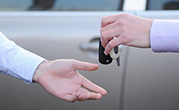Before buying a used car?

Buying a used car can be risky, so it is important to determine the possible pitfalls beforehand.
Buying from a garage or reputable dealer should not be problematic, but when conducting a private sale more care needs to be taken.
It is essential that the relevant checks are carried out prior to the vehicle acquisition, because if the car is found to be stolen it will be immediately taken away from your possession.
Investing into a car is expensive and it is important to account for possible faults that can occur when becoming a vehicle owner.
That's why you must research the matter and carry out all the necessary checks before investing.
With the right advice it is possible to spot whether a car is worth buying, use the following tips as a guide before purchase.
CHECK THE CAR HAS NOT BEEN STOLEN
- The seller must have the original V5C registration certificate with the car's vehicle's number plate on.
- Ask to see the V5C and check the watermark can be seen through the paper layers of the document.
- Double check there are no spelling mistakes on the document.
- Check the sellers name appears on the V5C.
- Make sure the address on the document is the same as the sellers.
- Run a car data check to make sure the car has not been registered as stolen.
- Make sure the VIN is the same as what is shown on the V5C.
- Double check the engine number matches the V5C.
A used car obviously has history, it is important before purchase that the customer checks out as much of the vehicle's past as possible.
It is essential that before purchasing you carry out an HPUI check on the car.
The HPI Check is designed to check whether the car has been written off previously.
Although some can be safely repaired, others should simply be assigned for scrap, but that does not mean they will.
The HPI Check will do the following:
- It will identify whether the vehicle was previously declared a total loss.
- It will search the National Mileage Register database which will ascertain whether the car that is showing low mileage has actually a lot more.
- It will confirm the car's make, model, door plan, vehicle's current colour and prior colour, transmission, and engine size.
- It will identify how many times the vehicle has changed hands and reveal the year the car was manufactured and the date it was first registered.
- It will list the plate changes the car may have had.
- It will indicate the current market value of the car.
VIEWING THE CAR
Before spending time and money on going to view a car it is important to gather as much information about the vehicle as you can beforehand.
Contact the seller and ask about the vehicle's past and present history. Try and find out as much information about the condition of the car as you can.
It is important to factor in any repair costs to the overall price of the car before buying.
Always arrange to view the vehicle at the seller's house, this is so you are confident the sale is legitimate and the car is not stolen.
If possible view the car in daylight with no rain; this is to give a clear idea of the state of the bodywork.
Check the car for rust, uneven gaps between panels on the car and any mismatched paint.
Don't be afraid to ask more questions and to point out damage, because this will affect the overall price and give you plenty of mileage with your negotiations.
It is essential that the car is test driven before purchasing so you are able to check how it handles and to make sure everything is in working order.
It is always worth checking how much wear there is left on the tyres and if the car is convertible take the roof on and off to make sure it fits correctly and the roof is not damaged,
Tell the seller you want to test drive it before arriving and sort out relevant insurance cover before going to view the car.
Make sure there are no unusual noises or vibrations when starting the car or when driving. A typical test drive should last between 15-20 minutes.
Do not feel pressurised into buying the car just because you have gone to see it. Do not be afraid to tell the seller you want to think about it and walk away.
BUYING THE CAR
Before negotiations begin, read up on how much the car is actually worth. Ask around and get quotes for any work you think might need to be done and use that when haggling.
Check when the road tax is due and how much fuel is in the tank as all these issues can be negotiated.
Once a price has agreed there are certain steps that must be followed to make sure the sale is legal. The correct paperwork proves ownership of the vehicle.
- Make sure the log book is genuine - there should always be a watermark inside.
- Check the logbook matches the VIN number on the car.
- Make sure the address in the logbook matches the address the owner is selling from.
- Take note of the car's mileage and make sure it matches up with whatever has been logged in the car's service history.
- MOT certificates should always be supplied with a car over three years old.
- Ask for a receipt which both seller and buyer should sign.
- Fill out the v5C new keeper section in the logbook and make sure it is sent to the DVLA.